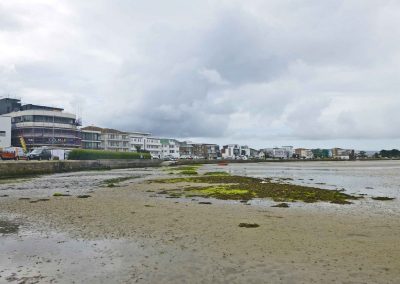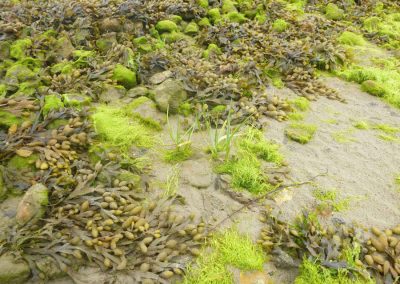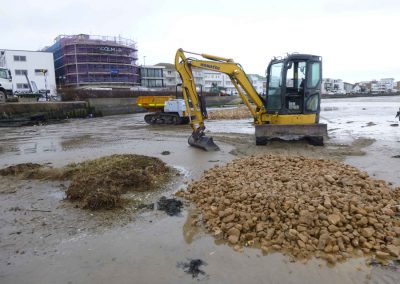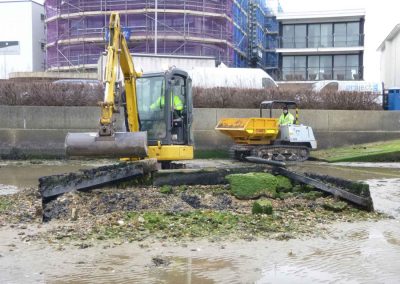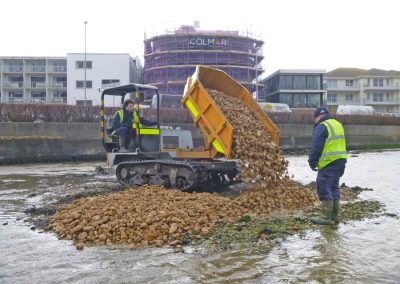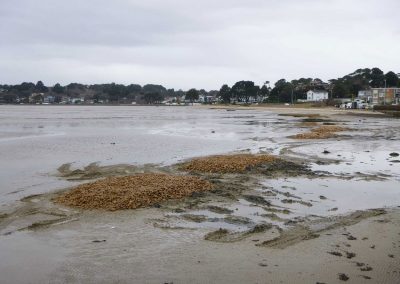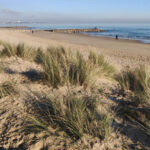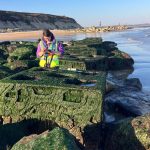Completed Projects
Whitley Lake Sea Defence Feasibility Study
2013-2018
A 5-
LEAD AUTHORITY
WORKING WITH
START DATE
LATEST UPDATE
Project Overview
The beach / foreshore at Whitley Lake has been eroding for a number of years. In places the erosion has reached the sea wall and in time will undermine the foundations.
This may be due in part to salt marsh die-
The Whitley Lake Sea Defence Feasibility Study undertakes to create and stabilise a saltmarsh foreshore and sandy beach in front of a hardened sea defence structure.
The aim is to identify if this type of intervention is suitable and sustainable as a “soft engineered” sea defence solution suitable for the inner Poole Harbour coastline at Whitley Lake.
Project Progress Reports
July 2016
Vegetation is a great way to increase accretion; sand and other material that comes in on the tide becomes trapped when the tide goes back out and on each tidal movement that material steadily builds up. With this in mind we planted some vegetation behind the island area in spring 2015 and in July 2016. After the spring planting we found that the stone islands had started to spread, some of the contents rolled back and unfortunately smothered the vegetation.
Learning from this we planted a little further back this month, to see whether the survival rate of the plants would increase. The plants die down during the winter so we will have to wait until late spring 2017 to see how many have survived the bashing of the waves and also how much material has accumulated.
March 2016
We had noticed for some time that sand seemed to be building around the stone islands at a faster rate than around the other structures. We needed to understand whether this was due to the location or to the material used to build the structures.
So in March 2016 we removed the troughs surrounded by wood and pipes and replaced them with placed piles of stone in the same location. We also put some of the stone around areas of remnant saltmarsh, hoping to encourage a build-up of material to help protect it from further erosion.
August 2013
Our photos below show the three different trials –
We believe it is a bit too early to say if the devices are working yet, although we have noticed some slightly different levels in the Harbour bed adjacent to the sites, predominantly at the plastic pipes. We have also noticed that the stone trial is slowly moving into a different shape and profile.
The Project
Due to the high cost of building a traditional sea defence wall and the environmental sensitivity of the inner harbour site, it was necessary to consider a low cost, very soft engineered solution for this study. It is anticipated that through ‘natural’ engineering it may be possible to grow a beach over a period of years and this potential merited detailed investigation.
The feasibility study will:
- Consider the best type of structure for growing a beach in a low wave energy environment.
- Consider what the best type of vegetation is to assist in accretion and stabilization of the beach/foreshore.
- Investigate how to germinate/transplant vegetation from other areas of the harbour.
- Consider the viability of using wind blown sand recovered from the local road network as a beach recharge medium.
- The reasonable time scale necessary to achieve the required beach width/height.
We propose to trial various methods to regenerate salt marsh and sand dune. Methods would be selected from options made by the Borough of Poole, Poole Harbour Commissioners, academic institutions and other stakeholders. The most promising options would be trialled on site.
The project would be designed to comprise three separate experimental zones, no larger than 20m in length by 10m in width. Each zone would focus on the use of different techniques to allow the development of a variety of practices. The performance of each zone would be monitored throughout the period of the project.
Techniques and materials considered included:
- Brush wood, hurdle or timber fences/posts
- Stone or rock islands.
- Dry stone wall / geobag enclosures.
- Geotextile to form sand bars.
- Deposition of silts, sand and gravels.
- Replenishment with wind blown sand recovered from the local highway network.
In parallel with the beach generation options above this project will also investigate how to stabilise the beach by colonising with indigenous harbour vegetation.
New vegetation could be transplanted from other sections parts in Whitley Lake, other areas of the harbour or imported from plant suppliers who specialise in the growth of wild plants.
The aim is to keep the trials on a small scale and monitor the results regularly over the period they are in progress to see how they are performing and what effects, if any, they are producing.
Borough of Poole are working in conjunction with Natural England to ensure there will be no adverse effects on the Poole Harbour SSSI and SPA.
If the trials are unsuccessful they will be removed at the end of the study period.





